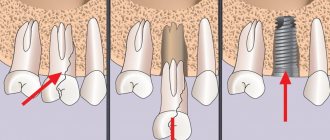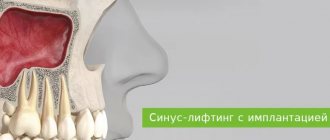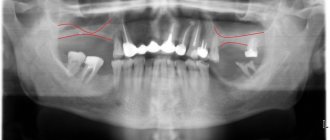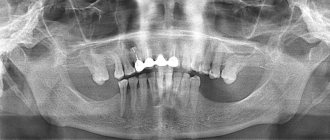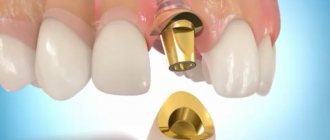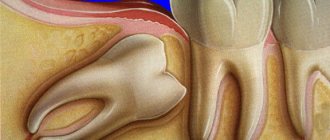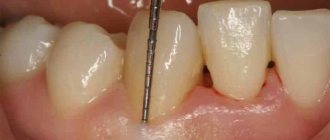All about sinus lifting in dentistry – when and why surgery is needed
Article navigation
- What is a sinus lift?
- Why does bone deficiency occur?
- Indications for sinus lift
- Contraindications to the procedure
- Materials for bone grafting
- Diagnosis before surgery
- Types of operations
- 1. Closed sinus lift
- 2. Open sinus lift
- How to Avoid a Sinus Lift
- Recommendations during the rehabilitation period
- Consequences and complications
- Reviews from doctors and patients
- Cost of the operation
Question for a specialist
When preparing for dental implantation, it often turns out that the jaw bone is too small in volume to install an implant into it. In this situation, the patient often requires extension – bone grafting or augmentation – so that the implant can still be fixed. Due to the structural features of the skull, plastic surgery for the upper and lower jaws is performed differently. For the upper jaw, a method called “sinus lift” is used. Next, we will talk about what kind of operation this is and how sinus lifting of teeth is performed in different ways - open and closed, balloon and ultrasound. We will also focus on compatibility with implantation and the nuances of the rehabilitation period.
Features: another name is subantral augmentation, “sinus lift”, “sinus graft”. The procedure takes place exclusively on the upper jaw. It is performed by an experienced maxillofacial surgeon, if necessary, in tandem with an ENT surgeon.
Choosing a sinus lift technique –
There are 2 main methods of sinus lifting - open and closed (we will describe these methods in detail below). The choice between them will mainly depend on how many mm in height it is necessary to increase the height of the alveolar process, raising the bottom of the maxillary sinus. And this will depend on how long the implants should be installed by the doctor, so that later they are not overloaded during chewing.
When the doctor determines the length of the implants and correlates it with the height of the alveolar process above the maxillary sinus, it becomes clear to him which sinus lift technique to use. To put it simply... when the bone height needs to be increased up to 4 mm (inclusive) - this is an indication for a closed sinus lift. But if the bottom of the maxillary sinus needs to be raised by 5-6 mm or more, then an open sinus lift is already indicated.
What is a sinus lift in dentistry?
A sinus lift is an operation to increase the height and volume of bone tissue, which is performed exclusively on the upper jaw. There are accessory air sinuses (or sinuses) around the nose and on the forehead - in this operation they work specifically with the voluminous maxillary sinuses, which are located above the roots of the lateral teeth of the upper jaw. They are lined from the inside with a thin protective film-shell. If you lift it, you can free up some space for filling with bone material, thereby increasing the size of the bone.
The word “lifting” is often used for various procedures in medicine and cosmetology. Therefore, some patients may confuse dental sinus lift surgery and cosmetic augmentation of the angles of the lower jaw or chin with hyaluronic acid fillers. In the first case, it means raising the bottom of the maxillary sinus to increase the height of the alveolar ridge and subsequent high-quality dental implantation. In the second case, the cosmetologist corrects the oval of the face using injections with a special gel. Augmentation of the chin or corners of the lower jaw can be done using implants made of porous polyethylene, but here you should contact a plastic surgeon with skills in performing maxillofacial operations.
%akc54%
Sinus lifting: turnkey price
How much does a sinus lift cost for 2022? The price consists of the cost of the operation itself + the cost of the necessary materials (bone material, and, if necessary, a barrier membrane). The prices below are for economy class and mid-price clinics.
- Open sinus lifting: price from 25,000 rubles; this cost does not take into account the cost of materials, such as a collagen membrane and grafted bone material. Taking into account these materials, the total cost of the operation can reach up to 50,000 - 60,000 rubles.
- Closed sinus lifting: price from 12,000 rubles is the minimum price recorded by us in Moscow. On average, the price will be about 17,000 rubles, but again this is only the operation itself (the cost of the bone material is additionally paid). For example, such high-quality material as Bio-Oss (packaging 0.5 g) will cost at least 13,000 rubles, although there are less expensive, but quite decent quality synthetic materials costing about 4,000-6,000 rubles.
What is the best bone material to use?
The best material is always autologous bone, i.e. bone, which is taken from the patient himself in other parts of the jaws. Usually the bone is taken from the area of the lower jaw or chin. However, given that the operation requires a fairly large volume of grafted bone, doctors usually use a mixture of the patient’s autologous bone with deproteinized bovine bone (having a high content of mineral components). An example of such a material is Bio-Oss.
In the looser bone of the upper jaw, it is important to use bone materials with a mineral component, but collagen-containing materials under these conditions will very quickly dissolve (resorb) and will not provide a significant increase in the volume of bone tissue.
Why does bone deficiency occur?
Not all patients have sufficient knowledge about their body, which sometimes leads to misunderstanding of the importance of certain procedures in dentistry. Here it is worth understanding what happens after tooth extraction. When, for some reason, a person loses a permanent tooth, the resorption of the spongy bone around the place (socket) where the roots were previously located begins almost immediately.
In the process of chewing food, the tooth received a load that extended to the jaw bone, forcing the microscopic blood vessels that penetrate the bone substance and nourish it to “work.” No roots equals no load. That is, in the “toothless” area, the bone is removed from work. The capillaries gradually atrophy, and the spongy substance left without nutrition is resorbed, because resolves, and outwardly it looks like bone subsidence. Already in the first 6 months, serious changes are noticeable, and after a year, resorption actually reaches its “peak”. As for the upper jaw, the bone substance here is more porous and light (compared to the lower jaw). It atrophies faster both from the outside and from the maxillary sinus - the latter case is often found in patients of retirement age.
Statistics show that if 70% of respondents (wearing removable or standard bridges) knew about bone atrophy and the discomfort that constantly shifting dentures bring, then dental implantation would be the preferred replacement for lost teeth. The implant uses the bone in which vital processes are restored, so atrophy practically does not occur.
Contraindications for sinus lift
Every procedure in dentistry has its contraindications. A good doctor will not recommend a sinus lift for oral infections or other conditions where the intervention would jeopardize the patient's health.
The list of absolute and relative contraindications is extensive:
- oral infections; periodontitis, caries, bone inflammation
- tumor diseases; conditions after chemotherapy and radiation therapy
- bleeding disorders of various origins, including warfarin use
- weakening of the immune system and slowing down recovery processes in the body
- systemic infections that can spread to the bone
- alcoholism, drug addiction or mental disorders
- severe allergies to medications
- heart failure
In order not to endanger your health, openly inform the surgeon about all existing diseases, even if it seems insignificant to you and not related to the operation.
Indications for sinus lift during implantation
The main indication is a lack of bone substance in the area of future implant installation, and if this area falls into the projection of the maxillary sinus - that is, in the absence of teeth in the lateral (distal) sections. Only an implantologist can understand when a sinus lift or bone augmentation is needed in principle. After all, each clinical case is unique in its own way and requires implants of different lengths. A lack of even 1 mm of bone may be an indication for osteoplasty surgery. Professionals also take on difficult situations when there is a lack of more than 8 mm of volume in the alveolar process. The standard indication is that the bone height is 6-8 mm or less.
In 60-80% of patients, there is a lack of height of the alveolar ridge of the upper jaw. The “risk zone” includes people who have lost teeth more than 6-12 months ago, patients with periodontal disease and dental cysts, as well as patients with certain anatomical features - when the bone septum is thin and short by nature. All these groups can undergo augmentation - of course, in the absence of contraindications.
Sinus lift and sinusitis
Often people accidentally find out that they have problems with the maxillary sinus. This usually happens during a routine examination at the dentist, when an orthopantomogram is taken for another issue and the doctor notices in the image that the mucous membrane of the maxillary sinus is thickened.
What to do in this case? No need to panic. There are many reasons for thickening of the maxillary sinus membrane, and not all of them require any additional treatment. The simplest thing is that the picture was taken at a time when the patient was infected with ARVI. A cold can cause the lining of the maxillary sinus to thicken as the body's response to illness. It is necessary to repeat the picture some time after complete recovery, and only then can conclusions be drawn.
In any case, it is recommended to obtain additional advice from an ENT specialist who will accurately determine the nature of the thickening of the maxillary sinus membrane. In the absence of inflammatory phenomena, there are no contraindications for surgery. Otherwise, an additional course of treatment for the maxillary sinuses may be required.
Contraindications to the procedure
Osteoplasty is not possible in the presence of acute immune diseases of the body (AIDS, HIV). Contraindications also include oncology, bleeding disorders, problems of the cardiovascular system, decompensated diabetes mellitus, too close to the bottom of the maxillary sinus (which makes it impossible to displace the membrane).
The presence of acute ENT diseases, caries or stomatitis are relative contraindications. Before surgery, it is imperative to completely cure a runny nose of any etiology (and constantly relieve allergic/medicinal rhinitis), as well as sanitize the oral cavity to minimize the risk of wound infection and other complications.
How is the operation performed?
During the procedure, the mucous membrane of the bottom of the maxillary sinus is carefully lifted, and the free space is filled with bone chips.
If there is minor atrophy and one artificial root is installed, a vertical (gentle) sinus lift is performed, otherwise an open (lateral) sinus lift is performed.
- Open method. Lateral sinus lift is performed as a separate stage before implantation. During the procedure, access to the bottom of the maxillary sinus is created through the anterior gingival wall and the alveolar process. Recovery takes 4-6 months, then implants are installed. The procedure replenishes tissue deficiency of any volume and is performed only in cases of severe atrophy.
- Closed method. Vertical sinus lifting is performed simultaneously with the installation of implants, so patients note this convenience. A section of the mucous membrane is detached from the periosteum, and a bed for the future implant is drilled into the bone. The hole is filled with crumbs and titanium roots are installed. The planted material and artificial roots take 3-6 months to take root, after which the crowns are fixed.
The choice of technique depends on the condition of the bone, the structure and density of the alveolar ridge.
Materials for bone grafting
All types of materials used in sinus lifting can be divided into 3 types - autograft, xenograft and synthetic bone. Let us dwell in more detail on the features of each type.
Autograft
The best option for the procedure is the patient’s own bone – an autograft. A small piece is cut from the lower jaw or chin, then the material can be crushed and replanted while raising the floor of the maxillary sinus. The advantages of this approach are complete immune compatibility, i.e. the autograft takes root perfectly. But there are also disadvantages - sometimes a lot of material is required (which becomes traumatic for the patient, because after osteoplasty 2 operated areas will already heal). Disadvantages also include increased resorption of the autograft during the healing period; as a result, the patient sometimes requires repeated augmentation.
Previously, another type of natural material for osteoplasty was used - allograft. This substance is taken from a donor (most often cadaveric material is meant) and goes through several stages of processing and disinfection. The material is outdated due to unstable survival rate and ethical component.
Xenograft
Bone replacement materials of animal origin are obtained from bovine bone. The substance is crushed, sterilized and part of the impurities – collagen (or protein, protein) – are removed. The result is a substance that is sorted according to the diameter and shape of the particles - crumbs with a diameter of 0.25-1 mm, chips - from 1 to 2 mm, granules - from 4 to 6 mm. The crumbs can be pressed into blocks up to 3 cm long.
A large amount of proteins makes the material less dense, which reduces the fixation ability when installing an implant. It is considered optimal when the material contains at least 75-90% minerals, and the rest is collagen.
Xenografts have good survival rate and relatively low cost, so this type is often used in osteoplasty. After surgery, the material begins to interact with surrounding tissues. Gradually, your own young bone is formed, and the graft is absorbed. The following materials are widely used for augmentation: Swiss Bio-Oss from Geistlich Pharma and Russian Osteomatrix. Similar bone materials can be mixed with autografts.
Synthetic material
Synthetic bone has a complex mineral composition, presented in the form of granulate - medical two-phase calcium phosphate. It contains artificial crystalline hydroxyapatite and beta-3-calcium phosphate (an analogue of natural hydroxyapatite, which is the main building block of bone). The diameter of the granules is about 0.2-2 mm. After replanting, two-phase calcium phosphate is also gradually replaced by living young bone. Popular brands that have confirmed their high quality and biocompatibility are BoneCeramic from Straumann and Maxresorb from Botiss Dental.
Very often, along with augmentation, a PRF membrane (or PRF, PRP) is applied. This is a thick gel-like preparation obtained from the patient's own blood. The membrane contains a huge amount of fibrin protein, platelets and growth factors, which actively stimulate regeneration processes. This method will be a significant addition to osteoplasty, especially if large areas were operated on - this way the patient’s rehabilitation will be much faster and less painful.
Types of grafts for sinus lift
There are different types of osteoplastic material. In modern surgery and dentistry, the following types of transplants are actively used:
- The patient's own bone tissue (autogenous). This type of osteoplastic material takes root the fastest, and the risk of rejection is minimal. Tissue is collected from the chin, one of the jaws or the hard palate. The disadvantage of such transplants is unnecessary trauma to the patient, increased duration of surgery and rehabilitation. ( It has not been carried out in our Center for many years ).
- Human bone tissue taken from cadavers (allogeneic). The material goes through many modern treatments and purifications. Such a graft was previously widely used in osteoplastic operations; it is very popular among clinic owners for its low cost. It is rarely used for sinus lifting in Moscow, but often in the regions of Russia. ( Never used in our Center ).
- Transplants of animal origin (xenogeneic). Modern dentistry has developed a technology for cleaning and forming stimulating grafts from cattle bones. Such materials are sometimes grouped under the general name "Bio-Oss". They have a specific fine-crystalline structure, which improves and accelerates the regeneration of the patient’s own bone. Slowly resorbing, the material is replaced by its own new bone and is often used as a scaffold.
- BMP. These may also be synthesized proteins that locally accelerate the formation of new bone.
The dentist chooses a transplant together with the patient, since the cost, ethical component and religion of the patient are of great importance. Typically, the doctor will recommend the optimal type of osteoplastic material. This must be agreed upon and discussed separately, as the ideal and optimal solution may be an unexpected surprise for the patient's budget. Sometimes it happens that preparatory osteoplastic operations are more expensive than implantation.
Diagnosis before surgery
To properly plan the procedure and select the optimal one, it is necessary to undergo diagnostics. An important step is to refer the patient for a computed tomography (CT) scan - this way the doctor will have a complete picture of the structure of the upper jaw and maxillary sinus, as well as the exact measurements of the thickness of the bone and sinus membrane. Additionally, blood tests are required, at a minimum - general clinical and to determine glucose levels. If certain diseases (endocrine or cardiovascular) are detected or present, you will need to consult a specialized specialist and prescribe therapy.
Is the method dangerous?
Patients are afraid of surgery, consider the method traumatic, and do not want to wait for the end of long-term treatment. In fact, the method is safe and physiological - the implant is implanted into the spongy bone of the required size, securely fixed and withstands full loads during chewing.
Real possible risks of the operation:
- perforation of the sinus mucosa - is solved by closing the perforation during surgery;
- wound infection - due to insufficient postoperative care;
- continuous bleeding - if problems with blood clotting disorders are not identified at the diagnostic stage.
Among the concerns of patients are changes in voice, runny nose, and chronic sinusitis. But no such consequences were identified; the operation does not affect the functioning of the maxillary sinuses. The rise of the bottom is small, sometimes even below the natural norm.
Types of operations in dentistry
Implantologists around the world have been using augmentation for more than 30 years to create a strong foundation for dental implants in the upper jaw. How is a sinus lift done? There are only 2 main types of procedures:
- closed or soft: if the bone height is more than 5 mm,
- open: if the alveolar ridge bone height is less than 4 mm.
A number of clinics offer a procedure called Bio Sinus Lift. In essence, this is a standard operation, but with a “selling” name. The difference between this method is that only natural materials without synthetics are used for augmentation: auto- or xenografts. Or if during the operation a biological clot is implanted - a PRF membrane.
Osteoplasty is performed without incisions in the skin and muscles of the face; all work is carried out from the oral cavity. Regardless of the type of operation, the procedure is performed under anesthesia. If the patient is very afraid, xenon sedation or general anesthesia is possible. But usually standard anesthesia is sufficient - a sinus lift lasts about 30-60 minutes. When are sutures removed after surgery? After about 5-10 days - depending on the size of the operated area.
Another “advertising variety” is ultrasonic sinus lifting. In fact, this is not a separate procedure, but a companion technique for open and closed types, and for other methods of bone augmentation. The bottom line is that the dentist uses a special ultrasonic device as a bur - a piezotome. Also, instead of a scalpel, a laser beam can be used.
Closed type of procedure
What is a closed sinus lift - this is the name of the procedure with minimal trauma to the gingival and bone tissues, when the bottom of the sinus and bone grafting is carried out through a small vertical hole in the lower part of the alveolar ridge. As a rule, a one-way method is used – i.e. restoration of teeth from only one part of the row. This is the simplest (for the patient) type of operation. This is explained by the fact that when replanting bone material, implants are usually installed immediately, that is, the use of simultaneous dental implantation. How is a closed operation performed? Let's consider all the stages in order:
- Stage 1: one or more holes are created in the gum and then in the bone (according to the number of implants). The doctor acts very carefully so as not to damage the sinus lining (this is why CT data is needed).
- Stage 2: the necessary instruments are inserted through the “passages” formed in the bone, and the bottom of the nasal sinus is carefully shifted,
- Stage 3: the resulting cavity is gradually filled with artificial bone and fibrin clot,
- Stage 4: Immediately after placing the transplant, implants are installed - holes through which osteoplasty is carried out, their dimensions are specially created. Next, plugs are screwed into the implants,
- Stage 5: a collagen membrane is applied (it holds the implanted bone and promotes regeneration), the gum is sutured.
The main condition for a closed-type operation is the presence of the patient’s own bone of 5 mm or more in height (which is required for the primary fixation of titanium implants). Using the procedure, you can install 1-3 implants at the same time.
How does a closed sinus lift work? It can be carried out in two ways:
- balloon method: lifting with air using a special ball, which, when inflated, lifts the bottom of the sinus. Refers to the most gentle and safe technique,
- mechanical: the mucous membrane is carefully lifted with hand instruments.
Open procedure type
What is an open sinus lift and how is it done? The open type is a complex and complete surgical operation, the indication for which is a pronounced lack of bone substance or the absence of more than 3 chewing teeth in a row. To raise the bottom of the maxillary sinus and introduce bone material, several small holes are not enough (as in the previous method). First, a gingival flap is peeled off in the projection of the sinus. Then the doctor performs an osteotomy - cutting out a large “window” on the side of the bone. Then the lining of the maxillary sinus is lifted. As a result of manipulations, a little free space is freed up. The operation can then continue in 2 scenarios:
- with one-stage implantation (installation of implants): if the lack of bone is 5-6 mm, then the implants can be installed immediately - you just have to additionally make vertical holes for them from below. Then the graft is introduced through the side “window”, a membrane is applied (if necessary), and the gum flap is sutured,
- without immediate installation of implants: bone material is inserted and a membrane is applied. Next, the gum flap is placed in place, stitches are applied, and after 3-4 months the implants can be placed. This type of open osteoplasty is used when the initial bone height is 4 mm or less.
During the creation of an opening in the bone, perforation of the sinus lining may occur. The doctor may stitch it up and continue with the sinus lift, or put stitches and postpone surgery until it is completely healed. To avoid the risk of damage to the mucosa, which adheres quite tightly to the bone, the best option would be to choose a piezoelectric tip with diamond coating. Such an instrument creates vibrations rather than rotation, so the osteotomy is performed with greater precision.
How is maxillary sinus lift surgery performed?
The success of any osteoplasty depends entirely on the experience and professionalism of the attending physician. If there are no contraindications, the operation is performed together with the installation of the implant. The day before surgery, antibacterial therapy is prescribed. The duration of a sinus lift is from 15 to 40 minutes (depending on the volume).
Sinus lift stages
- Consultation and diagnosis.
Checking the condition of the oral cavity, blood tests, x-rays or computed tomography to assess the condition of bone tissue and the structure of the maxillary sinuses. - Anesthesia.
Sinus lifting under general anesthesia is rarely performed. As a rule, local anesthesia is sufficient. - Surgical stage.
The protocol and nuances of the operation vary depending on the type of operation.
Bone material for sinus lift is usually of animal or synthetic origin. Often during surgery, resorbable membranes are also used, which act as a barrier between the osteoplastic material and the mucous membrane of the maxillary sinus.
Differences between open and closed procedures
What is the difference between open and closed sinus lift? All the features of each variety have been described in detail above. But, in short, with the open type of operation, a large “window” is created on the side of the jawbone, through which the bottom of the sinus is raised and the graft is inserted. This is more traumatic, recovery takes longer - complications arise more often, and there are more dietary restrictions. Unlike the open type, the closed type does not need such a “window” - small round holes at the bottom are enough. Since tissues are injured less, complications occur less frequently, and rehabilitation occurs faster.
Complications after closed sinus lift
With the proper qualifications of the doctor and the patient’s attentiveness to his health, the successful outcome of the operation is beyond doubt. Any type of sinus lift is a predictable and reliable way to restore bone tissue, however, complications can arise here too. All possible risks during closed sinus lift can be divided into three categories.
✔
Mechanical damage.
Perforation of the Schneiderian membrane is the most common complication of closed sinus lift. If the diameter of the hole is 1 - 2 millimeters, then there is nothing to worry about; for more serious damage, you need to carry out manipulations to restore the membrane or abandon the procedure.
✔
Infection.
It can occur during the operation or after its completion, when the inflammatory process occurs due to poor hygiene or ignorance of the rules of care and rehabilitation. Lack of treatment leads to bleeding, extensive inflammation, fistulas, and so on.
✔
Implant mobility and displacement of bone material.
Occurs due to stress and damage to the surgical area, and can also be caused by medical error.
How to Avoid a Sinus Lift
Is implantation possible without sinus lift? In general, the ideal option would be a timely visit to the implantologist after tooth extraction (or even before extraction, but when all the prerequisites for this are present), before the bone substance has time to atrophy. How else can you do without raising the sinus floor and building up the bone? If the dentist, after studying the images, still insists on performing osteoplasty of the upper jaw, then it is worth considering alternative approaches - dental implantation with immediate loading, the basal method. But this is only provided that you need to restore from half of the dentition to all the teeth, otherwise there will still not be enough space for the implant (for a vertical, not an inclined installation).
The principle of attaching implants to bone tissue with immediate loading protocols allows complex areas of atrophy to be bypassed in 50% of cases. And the prosthesis can be installed within 3 days after implantation. These techniques often become a panacea for people with bone atrophy, but not always. Therefore, before making a final decision, we recommend visiting an implantologist who practices the Immediate Load method and consulting with him.
How to avoid risks and complications?
Although the sinus lift has been used worldwide for over 30 years, it is a technically challenging procedure. Additional complications may arise from anatomical formations in the maxillary sinus, for example, septa dividing the sinus into several cells. The membrane can be so thin that it ruptures during a sinus lift from a banal exit through the nose.
How to avoid health risks if you are indicated for a sinus lift? The main thing is to trust a qualified implantologist who will take the correct treatment tactics even in a difficult case. Be prepared for the fact that the treatment period for severe bone tissue atrophy can be significant, a year to a year and a half.
The best bone grafting is the one that doesn't take place. If it is possible, without compromising the reliability of the treatment plan, to avoid bone grafting, then you can install shorter implants or bypass the maxillary sinus by installing implants at an angle.
Recommendations during the rehabilitation period
Sinus lifting is considered a traumatic procedure with a long recovery period. And almost all patients are concerned with questions such as how long it will take for the wound to heal, when the swelling will subside, how to eat properly or which side to sleep on, what not to do after treatment, why not to fly on an airplane, go to the bathhouse, play sports, etc. To reduce the number of possible negative consequences after surgery, you should be very careful about all the recommendations of your doctor:
- do not forget about drug therapy: take all prescribed medications in a timely manner - antibiotics, antihistamines, use medicinal dental ointments and gels, make cold compresses, do not heat the cheek. The pain will gradually disappear by day 5-7, and swelling may increase on day 2-3, and then subside within 3-5 days. The wound can heal completely in 7-14 days,
- you need to fully rest and devote enough time to sleep: at work you will have to take sick leave - for at least 3 days,
- follow a certain diet: in the first week before the sutures are removed - only soft or ground food, warm (neither hot nor cold). Too hard foods should be excluded from the diet. Chew on the healthy side without putting pressure on the affected area. Failure to comply with the diet can lead to displacement of implants and a decrease in the volume of implanted materials,
- physical activity should be excluded: any serious physical effort or active sports before the sutures are removed can lead to unpleasant consequences. Also, you should not pick up something from the floor by bending towards the object - any changes in body position are made only with a straight back (that is, you first need to sit down and then straighten up),
- Air travel is prohibited: pressure changes contribute to the narrowing and expansion of blood vessels, bleeding, loss of bone chips,
- postpone visits to the pool and saunas: jumping into water and diving are also not allowed - this is also associated with changes in the lumen of blood vessels (it narrows from cold, expands from heat). Bleeding may begin, swelling or inflammation may increase,
- You should not drink from a straw: low pressure is created in the oral cavity, but in the maxillary sinus it remains normal. This creates a threat to the integrity of the sutures and the extrusion of bone substance into the oral cavity,
- you should not blow your nose: after the procedure, transparent contents may come out of your nose - you should not blow it to avoid pressure changes in the sinuses - it is better to simply wipe your nose with a paper napkin,
- It is better to sleep on the healthy side or on your back (with a high pillow under your head): so as not to stimulate a strong blood flow to the “sick” side.
Is it painful to do?
The procedure in most Russian clinics is performed under local anesthesia.
In our Center we use short-term combo sedation
This is not anesthesia and does not require tests or long preparation. This is a modern and safe sleep treatment, but without complete immersion.
Levin Dmitry Valerievich
Founder and Chief Doctor of the Center
The use of drug sedation is the best option - the patient is in a calm, half-asleep state and can easily tolerate treatment procedures. The operation is not accompanied by unpleasant sensations, and to relieve pain during rehabilitation, the doctor prescribes analgesics; all medications will be given to you immediately after the operation; you do not need to go to the pharmacy. If recovery proceeds without complications, long-term use of painkillers will not be required, usually no more than three days.
Consequences and complications of surgical intervention
Is a sinus lift dangerous and is it worth doing? This is a rather complicated procedure that scares off many people due to the presence of a large list of unpleasant consequences. However, if the surgical intervention is performed by a professional and experienced doctor, and the patient follows all his recommendations before and after, problems should not arise. However, this is an ideal situation when all risks are excluded - therefore, information about possible complications and their symptoms can be very relevant for patients. Let's look at the dangers of subantral augmentation - the most common problems that arise after the procedure.
Complications due to medical error
As mentioned above, osteoplasty is performed by a maxillofacial surgeon - and it is favorable if the clinic has an ENT surgeon (who can help with perforation of the maxillary sinus). But not all institutions have specialized specialists. You should approach the choice of a clinic very carefully and find out in advance about the qualifications and experience of the doctor. Complications arising due to the fault of the doctor are most often associated with the following situations:
- illiterate planning of the procedure: for example, they incorrectly determined the height of the bone and chose the wrong method of operation or implanted substance. As a result, the graft may not take root or be quickly resorbed,
- lack of experience: violation of technology or sanitary standards.
Possible complications during the sinus lift operation itself:
- perforation of the sinus wall: occurs in 25% of clinical situations. The membrane can be damaged during an osteotomy, raising the sinus floor with an instrument, or when installing an implant. Immediate suturing of the membrane (if it is sufficiently dense) or application of a collagen absorbable membrane will be required,
- insertion of a bone graft into the maxillary sinus: if the doctor did not notice the perforation. May manifest as sinusitis, pain, bloody or purulent contents from the nose,
- bleeding at the time of osteotomy: also occurs quite often - the doctor eliminates the problem on the spot,
- infection of the operated area: surrounding tissues may fester, chronic sinusitis may occur after surgery, as well as sinus cysts and sinusitis.
Complications due to violations on the part of the patient
If the patient does not follow the doctor’s recommendations or conceals information about diseases that can negatively affect the quality of maxillary augmentation, the following complications may occur:
- inflammation of the maxillary sinus,
- bleeding and sharp pain in the operated area,
- wound infection, bone inflammation,
- mobility or rejection of implants,
- pushing implants deep into the sinus: due to non-compliance with nutritional rules,
- loss of the graft: with a strong cough or sneeze, the stitches may come apart and the material may spill out,
- development of ENT diseases.
Dental implantation using the Osstem system = 18,500 rubles. until January 15, 2022!
All inclusive, treatment guaranteed!
Premium implants at an affordable price. Free consultation with an implantologist +7 (495) 215-52-31 or write to us
A negative consequence may be non-engraftment of the bone material or its rapid resorption. In general, the percentage of effectiveness of the operation (without simultaneous installation of implants) is in the range of 40-60%. That is, 4-6 patients out of 10 will have to undergo the procedure again - and this also does not always give a good result. It happens that due to constant interventions, your own bone becomes so small that augmentation can no longer be carried out. Therefore, it is better to either immediately choose implantation with immediate loading, or do extensions with simultaneous implantation.
Innovative sinus lift techniques
Dental procedures are constantly being improved to make patient treatment as safe and comfortable as possible. Sinus lifting is also improved and modified, reducing the risk of adverse surgical outcomes. Innovative technologies are not available in all clinics, as expensive modern equipment and constant improvement of the qualifications of maxillofacial surgeons are required. Specialized centers usually do not offer classic or retro technologies, but promote advanced or modified types of sinus lifting.
Balloon sinus lift
Balloon sinus lift is a type of gentle closed surgical procedure. To reduce the likelihood of rupture of the mucous membrane of the maxillary sinus, special balloons are used.
The sinus lift technique is as follows:
- Creating access to the maxillary sinus through the implant bed;
- Installation of a special thin mandrel driver and its fixation to the sinus mucosa with a coupling;
- Installation of a special cylinder in the space closest to the membrane;
- Injecting a contrast agent into a balloon under a certain pressure and under X-ray control, obtaining space for bone material, removing the balloon;
- Filling the resulting cavity with granules of bone material;
- Installation of the implant in a pre-formed bed.
Gentle peeling of the protective membrane of the maxillary sinus from the periosteum minimizes the risk of rupture and infection. This sinus lift technique is often used in most clinics.
Modified sinus lift
This type of sinus lift differs from the usual classical techniques in that the space between the periosteum and the mucous membrane of the maxillary sinus is filled with combined sandwich blocks of BMP bone regeneration stimulators and pasty bone material or granular material. Its elements should be large so that there is no risk of microperforation of the maxillary sinus. Many surgeons previously used the patient's own tissue, crushed after collection, or special synthetic materials.
Reviews from doctors and patients
Sinus lifting is often the only solution for people with bone atrophy - a statement that most doctors agree with. But professionals also consider alternative methods (discussed above) to be an excellent solution. A lot here depends on the individual characteristics of the body. Patient reviews of maxillary augmentation vary greatly - this is mainly due to their well-being during the rehabilitation period. The fastest recovery occurs after a closed sinus lift with the additional use of a membrane.
Rehabilitation after closed sinus lift
Despite the fact that closed sinus lift is a gentle procedure, the postoperative rehabilitation rules are quite strict. In the first days after surgery, you should exclude solid, hot and spicy foods from your diet, and treat the intervention area with antiseptic solutions. Teeth brushing is carried out on the second or third day using a soft brush. In the first days, discomfort, swelling and slight bleeding are possible: these symptoms usually disappear on the third or fourth day. For two to three weeks, a number of restrictions should be observed that directly affect the healing and recovery process.
- Limiting physical activity for a month.
- Avoid air travel for at least two weeks.
- Avoid visiting the sauna and swimming pool for a month.
- Smoking and drinking alcohol are not recommended for two weeks.
If the operation was successful and the patient follows all the doctor’s instructions and recommendations, there is no need to worry about the results of the treatment.
Cost of the operation
How much does a sinus lift cost? The average price of closed-type augmentation is 25 thousand rubles, and the open type costs higher - about 30 thousand. If a synthetic or animal graft is needed, the cost will increase by approximately 10 thousand rubles. Membrane application – from 15 thousand. The price of preliminary sanitation of the oral cavity is very individual - it may be that it is not needed at all, but most often it is necessary to cure several carious teeth and have professional oral hygiene done. You can also save on treatment. For example, if you go to a regional clinic or choose Russian material for osteoplasty rather than foreign. When implants are installed at the same time, the cost of treatment also increases.
Author: Bespalov R. D. (Thank you for your help in writing the article and the information provided)
How are the protocols different?
Both operations involve the introduction of bone material into the area of the bottom of the maxillary sinuses when there is insufficient bone tissue at this point for reliable fixation of the implants. Our Center uses a bone growth stimulator, which is gradually activated and produces protein growth factors (similar proteins appear during the formation of “callus” during bone fractures). The new volume fuses with the main bone and forms a single whole, creating ideal conditions for implantation with a lifetime guarantee.
The technologies differ in the way they create access to the maxillary sinus:
- With a closed protocol, all manipulations are carried out vertically - directly through the implantation bed. A tunnel is created in the bone at the site of the future implant, and optimal access points to the sinus are selected - the best dense areas of the bone septum to create an opening in it for access to the sinus.
- With an open sinus lift, a horizontal approach is created - through a small “window” of up to 5 mm in the anterior wall of the bone. From the side of the oral cavity, a small opening of the gum is made, a hole is created that resembles a “door” on the lateral (outer) wall of the sinus, opening under the mucous membrane.
Further, the tactics are identical - using special instruments, the thin mucous membrane lining the bottom of the maxillary sinus is carefully moved without tearing. The bone tissue regeneration stimulator is injected under the mucous membrane, which then tightly covers it from above. After the stimulator is absorbed, the effect that causes the bone to harden and grow disappears, leaving at the injection site its own new bone, formed without the participation of synthetic drugs, donor materials and transplanted bone blocks.
Microsurgical operations are performed directly at the maxillary sinuses and require the doctor’s exquisite skill to avoid violating the integrity of the delicate membrane. It is better to entrust such an operation to an experienced specialist who understands the anatomical features of the maxillofacial region.
Sinus lifting using the author's non-traumatic technique
We do not use punitive, outdated hammer and chisel protocols. Ultrasonic effects on bone are as gentle and gentle as possible. The operations are performed by highly qualified maxillofacial surgeons. This is an ordinary routine event for our specialists, who carry out complex operations every day, have honed skills and excellent clinical thinking.
Levin Dmitry Valerievich Chief physician and founder of the Doctor Levin center
Preparatory stage
In our Center, special attention is paid to the preparatory stage - it allows you to assess the existing problem as accurately as possible, choose a surgical technique, prepare the patient in the presence of obstacles, and make the necessary calculations. This will minimize the risk of possible complications at subsequent stages of sinus lifting.
- Initial consultation The condition of the oral cavity is assessed, an anamnesis is collected to identify concomitant diseases that may become an obstacle to intervention. If necessary, an ECG is performed (possibly in our Center). Patients with somatic diseases are referred for general tests.
- Computed tomography is performed on a high-precision SIRONA GALILEOS device with ENT mode settings. Allows you to accurately, down to millimeters, estimate the thickness of the bone plate and select the surgical technique. Analyze the general condition of the upper jaw and sinuses, identify associated pathologies (for example, cysts of the maxillary sinuses).
- Examination by a regular ENT doctor Patients with suspected inflammatory processes in the maxillary sinuses are examined and, if necessary, treated by an ENT doctor. It is important to exclude the possibility of infectious processes in the sinuses and to prevent the development of complications after sinus lift.
- Sanitation of the oral cavity Treatment of caries, pulpitis, removal of failing teeth, and professional oral hygiene are carried out. This eliminates the risk of infection in the surgical area.
Read more about preparing for a sinus lift here - Preparing for a sinus lift and bone grafting
How to choose a protocol
Unfortunately, the patient cannot independently choose which protocol the operation will be performed according to; everything depends on the surgeon’s verdict. There are approximate anatomical data on which the doctor relies when choosing one method or another. The bone for placing the implant, located under the wall of the maxillary cavity, is divided according to height into 4 groups:
| Bone height | Sinus lift method |
| 8-10 mm or more | a sinus lift is usually not required |
| 6-8 mm | closed sinus lift |
| 5-6 mm | borderline case - closed or open protocol |
| less than 5 mm | open protocol |
Bone height is measured on an x-ray - this is the size of the light stripe on a CT scan at the site of missing teeth to the dark air bubble of the maxillary sinus.
The quality of the diagnostic images determines whether the protocol was chosen correctly and whether the surgeon missed the individual features of the sinus structure . Sometimes there are situations when none of the methods can be applied due to the discovery of obstacles to the operation before they are eliminated. For example, inflammation of the sinus, neoplasms in the form of cysts or polyps. Photos taken no more than 8 weeks ago are considered reliable.
In our Center, diagnostics are carried out using a modern SIRONA GALILEOS computed tomograph (Germany). Configured and calibrated in ENT mode, which allows you to obtain high-precision 3D images, accurately determine the size and structure of bone tissue, and assess the condition of the maxillary sinus. The pictures are available and located in your Dropbox Personal Account.
If you have already been consulted by an oral and maxillofacial surgeon, an x-ray will remain on your hands or disc. Keep it with you. Even over time, the images are a comparative and diagnostic tool.
Read more about surgical planning - Preoperative assessment and planning
We guarantee positive sinus lift results!
If the result is important to you, you do not want to have a cadaveric or animal bone planted in your sinus, which often does not take root and festers, choose BIO sinus lift.
At the Bionic Dentis clinic, you can use a unique service - BIO sinus lifting - which is successfully used in premium implantation clinics in leading European countries.
At the end of 2022, the Bionic Dentis dental clinic was the only clinic in Moscow that performed this operation according to the European protocol.
Ozerov Petr Vladimirovich
Chief physician. Dentist, implantologist, orthopedist, surgeon. Laser dentistry specialist
More details
Andreev Dmitry Lvovich
Dentist orthopedist-implantologist.
More details
Frolov Andrey Konstantinovich
Orthopedic dentist
More details
Indications
There are two main indications for a sinus lift:
- Inability to place an implant of the correct size and shape . After tooth extraction, the bone atrophies and decreases in size without load. In addition, placement of an artificial tooth root often requires a larger volume of bone tissue than was necessary to fix the original one.
- Formation of a fistula between the oral cavity and the maxillary sinus or protrusion of the roots of the teeth into the lumen of the sinus . These conditions can develop as a result of injuries or inflammatory and infectious processes.
Possible complications
Sinus lifting of the upper jaw is safe if it is performed by a specialized dentist in a clinic with the necessary equipment. However, in some cases, negative consequences may occur both during the operation itself and during the rehabilitation period:
- perforation of the maxillary sinus;
- pushing the implant into the sinus;
- development of acute sinusitis, which, if left untreated, can become chronic;
- poor fastening, mobility of the structure;
- wound infection;
- bleeding from the nose or wound;
- implant rejection.
Immediately after the procedure, swelling, pain, and redness of the mucous membranes occur. Body temperature may increase. These phenomena go away on their own after a few days. To alleviate the condition, you can take analgesics, antipyretics, and rinse your mouth with antiseptics.
If infection or damage to soft tissue occurs, complications become apparent within the first 3 days. If the temperature rises, pain or swelling increases, you should consult a doctor.
Open sinus lift with implantation
Many people are interested in the question: is an open sinus lift with simultaneous implantation possible? The technique is indeed used, but very rarely, since its implementation requires almost ideal conditions:
✔
the height of the patient’s bone tissue should not be less than 5 millimeters;
✔
there must be good bone density;
✔
There should be no inflammatory processes in the oral cavity.
In the case of an open sinus lift and simultaneous implantation, the load on the implant should be completely eliminated for three weeks, otherwise displacement of the bone material may begin. Open surgery is usually not performed with immediate implantation, but waits for the material to engraft and the end of the rehabilitation period, which on average takes from 4 to 6 months.
